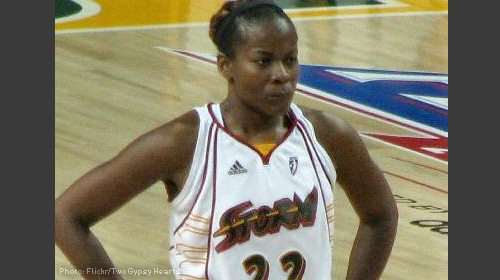
When NBA player Jason Collins announced this week "I'm gay", praise for his groundbreaking courage poured in from all directions. Collins' announcement is a very big deal, especially since the worldwide popularity of NBA basketball makes him a highly visible role model for youth. However, we shouldn't lose sight of where the Jason Collins milestone fits into the long history of openly LGBT people's participation in American professional sports. Generally speaking, women athletes have been faster to come out than men, athletes in individual sports have come out more rapidly than those in team sports, and athletes in relatively obscure sports have come out more quickly than those in more popular sports. The reasons for these patterns are complex and debatable, but particular examples of individual courage over the past three decades are clear.
Czech-American tennis great Martina Navratilova came out publicly as bisexual way back in 1981. Then a rising star, Navratilova went on to win a record total of 167 singles tournaments and become arguably the greatest women's tennis player of all time. She says that discrimination based on her sexual orientation "cost [her] plenty of money" over the course of her sports career, given sponsors' reluctance at the time to link their brands to her, but that didn't stop her from being vocal about LGBT issues. Navratilova even participated as one of the plaintiffs in the ACLU/Lambda Legal lawsuit challenging a 1992 anti-gay Colorado ballot initiative that ultimately resulted in the landmark Romer v. Evans Supreme Court decision. Following in Navratilova's footsteps, a number of female tennis and golf players came out of the closet during the 1980s and 1990s. In 2004, LPGA star Rosie Jones publicly announced she was a lesbian at the same time she announced a sponsorship deal with Olivia, organizers of lesbian-themed cruises and vacations, thus proving that the economic effects of coming out need not be all negative.
The WNBA began play in 1997. Despite – or perhaps because of – its reputation as a niche activity for lesbians, the WNBA had no out current players for many years. In 2005, reigning MVP Sheryl Swoopes of the Houston Comets broke through the "lavender ceiling" by publicly identifying herself as a lesbian (though later she married a man and distanced herself from both lesbian and bisexual identities). In the years following, more and more WNBA players have felt comfortable enough to publicly come out. Minnesota Lynx star Seimone Augustus and her fiancée spoke out against a 2012 ballot initiative that sought to write a ban on marriage for same-sex couples into the Minnesota constitution. Brittney Griner, who dominated women's college basketball for the past four years, was picked first in the 2013 WNBA draft by the Phoenix Mercury, days later officially came out as a lesbian, and days after that became the first out athlete to sign a sponsorship deal with Nike.
Women's soccer has also seen a few players come out publicly in recent years. Natasha Kai, then a member of the U.S. Soccer Women's National Team (and later also a member of the U.S. women's national rugby sevens team), mentioned dating a woman in a 2008 interview. Megan Rapinoe, star midfielder for the soccer National Team and formerly of the professional club Chicago Red Stars, gave an "I'm gay" interview just before the 2012 Summer Olympics, saying she felt it was important to do so given the National Team's influence as role models for youth.
Among male athletes, many competitors in sports that rarely get public attention or network television coverage have announced their gay identity to fans en route to Collins' blockbuster announcement. Those who have come out while still actively competing at the pro and/or Olympic level include featherweight boxer Orlando Cruz, gymnast Josh Dixon, figure skater Johnny Weir, bowler Scott Norton, equestrian Robert Dover, and lacrosse player Andrew Goldstein.
Openly transgender athletes at the pro level have been very rare, perhaps because the sex-segregated competition structure in most sports can create unique obstacles for transgender people. However, transgender tennis player Renée Richards made history in 1977 when she won a lawsuit seeking the right to participate in the women's draw of the U.S. Open. Just this year, mixed martial artist Fallon Fox came out as a transgender woman. Several current college athletes have publicly identified themselves as transgender, and a number of governing bodies for college and high school athletics have recently published policies clarifying transgender students' eligibility to participate, hopefully increasing the opportunities transgender people will have to excel at those levels and eventually reach the pros.
Learn more about LGBT rights and other civil liberty issues: Sign up for breaking news alerts, follow us on Twitter, and like us on Facebook.

